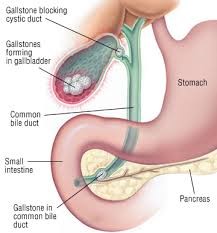By ZACHARY BOUCHER, MD

Your gallbladder really has just one job: the storage and excretion of bile (digestive juices) into your intestines.
Without bile, we would have trouble digesting food appropriately. But the gallbladder does not make bile, that’s the liver’s job. The liver sends bile down these special tubes called bile ducts down into your gallbladder. When we eat, we send a chemical signal to our gallbladder telling it to squeeze, which pushes bile into our intestines and its job is done.
So where do gallstones come from?
Gallstones are common. About 1/3 of all adults in the Unites States have gallstones. Gallstones form for a number of reasons. But most commonly, they just form randomly in our gallbladder and have nothing to do with lifestyle/dietary choices. Once these stones form, they almost never go away on their own.
Fortunately, only about 25% of people with gallstones ever have symptoms. Symptoms from gallstones arise when a stone blocks the duct that carries bile out of your gallbladder. When this occurs, your bile has nowhere to go and your gallbladder gets inflamed and angry. The pain from this can be severe and many patients come to the emergency room for treatment. Symptoms from this blockage can include abdominal pain, chest pain, right shoulder pain, upper back pain, bloating, nausea, vomiting and diarrhea. Thankfully, the offending stone blocking your duct often rolls away after a few hours and your symptoms improve. Some people find avoiding fatty foods helps with this pain. But long term, you will continue to have symptoms.

I recommend surgery to remove the gallbladder for anybody who has gallstones and appropriate symptoms. I do this for two reasons. 1) I want to make these symptoms go away. Living in fear of eating certain foods is not a way I want to live my life. And 2) I want to prevent a future emergency. There are three main ways gallstones can cause emergencies, and they all involve a stone going somewhere it is not supposed to and getting stuck in your bile ducts. In addition to being very painful, this can be life threatening and is also a common cause of pancreatitis.
The surgery to remove your gallbladder is very safe when performed by an experienced surgeon. Robotic surgery, in my opinion, has only made this surgery even safer for patients. The surgery involves 3 to 4 small incisions in your belly about the length of a long grain of rice. The surgery is usually less than one hour and you go home that same day. After surgery, your flow of bile adjusts automatically to no longer having your gallbladder for storage. The overwhelming majority of patients have no change in relevant flow of bile after surgery.
Treating gallbladder disease is a passion of mine because I truly believe it can improve people’s lives in a profound way. And every time we remove a gallbladder before it becomes an emergency, it is a potential life saved. If you have any more questions or would like to discuss your gallbladder further, please do not hesitate to make an appointment.
About the Author
Zachary Boucher, MD, is a General Surgeon with Lakeland Regional Health. To make an appointment with Dr. Boucher, please call 863.284.5030.
